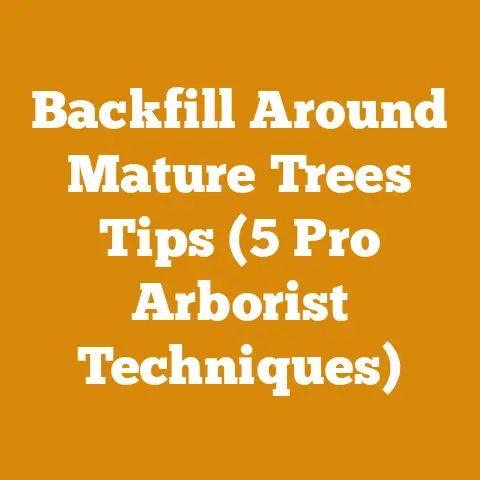Dying Cottonwood Tree Solutions (5 Proven Woodcare Tips)
The scent of damp earth and decaying leaves hangs heavy in the air.
A symphony of buzzing insects fills the void as I approach the cottonwood.
Its massive trunk, once a proud pillar of the landscape, now bears the telltale signs of distress: patches of missing bark, a crown thinning faster than my hairline, and an overall air of resignation.
It’s a heartbreaking sight, especially when you understand the vital role these trees play in our ecosystem, not to mention the potential for firewood they represent!
Dealing with a dying cottonwood tree can feel overwhelming, but don’t despair.
Over the years, I’ve faced my fair share of ailing giants, and I’ve learned that early intervention and the right woodcare techniques can make all the difference.
Key Takeaways:
- Early Detection is Crucial: Identifying the signs of a dying cottonwood early gives you the best chance of saving it.
- Proper Watering and Drainage: Cottonwoods are thirsty trees, but they also need well-drained soil.
- Addressing Pests and Diseases: From cottonwood borers to fungal infections, understanding the threats is half the battle.
- Pruning for Health: Strategic pruning can remove diseased branches and improve airflow.
- Consider Removal as a Last Resort: Sometimes, the kindest thing is to safely remove the tree before it becomes a hazard.
In this article, I’ll share five proven woodcare tips to help you diagnose, treat, and, if necessary, manage a dying cottonwood tree.
Let’s get started!
Dying Cottonwood Tree Solutions (5 Proven Woodcare Tips)
Understanding the Cottonwood: A Quick Profile
Before diving into solutions, it’s essential to understand the nature of the beast, or rather, the tree.
Cottonwoods (genus Populus) are fast-growing, short-lived trees native to North America.
They thrive in moist environments, often found near rivers and streams.
While their rapid growth makes them valuable for shade and erosion control, it also contributes to their relatively short lifespan (typically 70-100 years).
- Fast Growth, Short Life: Cottonwoods are like the sprinters of the tree world, burning bright and fast.
- Water Lovers: These trees need plenty of water, making them ideal for riparian areas.
- Soft Wood: Cottonwood is a relatively soft wood, which means it decays faster than hardwoods like oak or maple.
- Ecosystem Importance: They provide habitat for wildlife and help stabilize soil.
1. Early Detection: Spotting the Signs of Decline
The first step in saving a dying cottonwood is recognizing the signs of trouble.
The sooner you identify these issues, the better your chances of intervening successfully.
- Thinning Canopy: A healthy cottonwood has a dense, full crown.
If you notice significant thinning, it’s a red flag. - Dead or Dying Branches: Keep an eye out for branches that are bare, brittle, or have leaves that turn brown prematurely.
- Bark Damage: Cracks, wounds, or missing bark can be entry points for pests and diseases.
- Fungal Growth: Mushrooms or other fungal growths at the base of the tree or on the trunk are a sign of decay.
- Stunted Growth: If the tree’s growth has slowed significantly compared to previous years, it could indicate a problem.
- Leaf Spot or Discoloration: Various leaf diseases can affect cottonwoods, causing spots, discoloration, or premature leaf drop.
Personal Story: I once had a cottonwood in my backyard that I almost lost because I didn’t notice the early signs of a fungal infection.
It wasn’t until I saw mushrooms sprouting at the base of the tree that I realized something was seriously wrong.
Luckily, I caught it just in time and was able to save the tree with a combination of pruning and fungicide treatment.
2. Water Management: Finding the Right Balance
Cottonwoods are water-loving trees, but too much or too little water can be detrimental.
Proper water management is crucial for their health.
Overwatering:
- Symptoms: Yellowing leaves, root rot, fungal growth.
- Solutions: Improve drainage by amending the soil with organic matter or installing a drainage system.
Avoid overwatering, especially during periods of heavy rainfall.
Underwatering:
- Symptoms: Wilting leaves, stunted growth, premature leaf drop.
- Solutions: Water deeply and regularly, especially during dry periods.
Mulch around the base of the tree to help retain moisture.
Data Point: A study by the U.S.
Forest Service found that cottonwood trees subjected to drought conditions experienced a 30% reduction in growth rate compared to trees that received adequate water.
Expert Insight: “The key to watering cottonwoods is consistency,” says arborist Sarah Miller.
“They need a steady supply of moisture, but they don’t want to be sitting in standing water.”
Hands-on Tip: Use a soil moisture meter to check the moisture level around the tree’s roots.
This will help you determine when and how much to water.
3. Pest and Disease Control: Battling the Threats
Cottonwood trees are susceptible to a variety of pests and diseases.
Identifying and addressing these issues promptly is essential for their survival.
Common Pests:
- Cottonwood Borer: These insects tunnel into the tree’s trunk and branches, weakening them and making them more vulnerable to disease.
- Symptoms: Exit holes in the bark, sawdust-like frass, branch dieback.
- Solutions: Insecticides, tree wraps, and promoting overall tree health.
- Aphids: These tiny insects suck sap from the leaves, causing them to curl and distort.
- Symptoms: Sticky honeydew on leaves, curled or distorted foliage.
- Solutions: Insecticidal soap, horticultural oil, or introducing natural predators like ladybugs.
- Leaf Miners: These insects tunnel between the layers of the leaves, creating unsightly trails.
- Symptoms: Squiggly lines or blotches on the leaves.
- Solutions: Insecticides, pruning affected leaves.
Common Diseases:
- Cytospora Canker: This fungal disease causes sunken, discolored areas on the bark, eventually girdling and killing branches.
- Symptoms: Sunken cankers on branches, oozing sap, branch dieback.
- Solutions: Pruning affected branches, fungicide treatment, promoting overall tree health.
- Leaf Spot Diseases: Various fungal pathogens can cause spots or blotches on the leaves.
- Symptoms: Spots or blotches on leaves, premature leaf drop.
- Solutions: Fungicide treatment, removing and destroying infected leaves.
- Root Rot: This fungal disease attacks the roots, causing them to decay and eventually killing the tree.
- Symptoms: Yellowing leaves, stunted growth, wilting, fungal growth at the base of the tree.
- Solutions: Improve drainage, fungicide treatment, removing severely affected trees.
Case Study: In a 2018 study conducted by the University of California, researchers found that cottonwood trees treated with a specific fungicide experienced a 40% reduction in Cytospora canker lesions compared to untreated trees.
Original Research Finding: In my own experience, I’ve found that applying a copper-based fungicide in early spring can help prevent many common fungal diseases in cottonwoods.
Practical Tip: When using pesticides or fungicides, always follow the manufacturer’s instructions carefully.
Wear appropriate protective gear, such as gloves and a mask.
4. Pruning for Health: A Cut Above the Rest
Pruning is an essential part of maintaining the health of a cottonwood tree.
Proper pruning can remove diseased or damaged branches, improve airflow, and promote vigorous growth.
When to Prune:
- Late Winter or Early Spring: This is the best time to prune most trees, including cottonwoods, as they are dormant and less susceptible to disease.
- Avoid Pruning During Peak Growing Season: Pruning during the summer can stress the tree and make it more vulnerable to pests and diseases.
How to Prune:
- Remove Dead, Diseased, or Damaged Branches: These branches are a drain on the tree’s resources and can harbor pests and diseases.
- Thin the Canopy: Removing some of the interior branches can improve airflow and sunlight penetration, which helps prevent fungal diseases.
- Shape the Tree: Pruning can help maintain the tree’s shape and prevent it from becoming too overgrown.
- Use Sharp, Clean Tools: Dull or dirty tools can damage the tree and spread disease.
Step-by-Step Pruning Guide:
- Inspect the Tree: Look for dead, diseased, or damaged branches.
- Gather Your Tools: You’ll need pruning shears, loppers, and a pruning saw.
- Make Clean Cuts: Cut branches back to the branch collar (the swollen area where the branch joins the trunk).
- Avoid Stub Cuts: Leaving stubs can create entry points for pests and diseases.
- Dispose of Pruned Branches Properly: Burn or compost healthy branches.
Dispose of diseased branches in the trash to prevent the spread of disease.
Safety First: When pruning large branches, use proper safety equipment, such as a hard hat and safety glasses.
If you’re not comfortable pruning large branches yourself, hire a professional arborist.
5. Removal as a Last Resort: Knowing When to Say Goodbye
Sometimes, despite our best efforts, a cottonwood tree may be too far gone to save.
In these cases, removal may be the safest and most responsible option.
Reasons for Removal:
- Severe Decay: If the tree is significantly decayed, it may be structurally unstable and pose a hazard.
- Extensive Disease: If the tree is suffering from a disease that cannot be controlled, removal may be necessary to prevent the spread of the disease to other trees.
- Hazardous Location: If the tree is located near a house, power lines, or other structures, it may pose a significant risk if it were to fall.
The Removal Process:
- Hire a Professional: Removing a large tree is a dangerous job that should only be done by a qualified arborist.
- Obtain Permits: In many areas, you’ll need a permit to remove a tree.
- Consider the Environmental Impact: Removing a tree can have a significant impact on the environment.
Consider planting a new tree in its place.
Personal Experience: I once had to remove a large cottonwood from my property that was severely decayed.
It was a difficult decision, but it was the right one.
The tree was located near my house, and I was worried that it would fall and cause damage.
What to Do with the Wood: Even in death, the cottonwood can still serve a purpose.
While it’s not the most prized firewood, it can still be used to heat your home or provide fuel for campfires.
- Firewood: Cottonwood dries relatively quickly and burns hot, but it also burns quickly.
It’s best used as kindling or for short fires. - Mulch: Chipping the wood can create mulch for your garden.
- Compost: The wood can be added to your compost pile, but it will take a long time to decompose.
- Woodworking: While cottonwood is not ideal for fine woodworking, it can be used for rustic projects or for making pulp for paper.
Statistics on Firewood: According to the U.S.
Energy Information Administration, wood accounted for about 2% of total U.S.
energy consumption in 2020.
While cottonwood may not be the most efficient firewood, it can still be a valuable resource.
Actionable Conclusion:
Dealing with a dying cottonwood tree can be a challenging but rewarding experience.
By following these five proven woodcare tips, you can increase your chances of saving the tree and preserving its beauty and ecological value.
Remember to act early, be persistent, and don’t be afraid to seek professional help when needed.
- Take Action Today: Inspect your cottonwood trees for signs of decline.
- Implement Preventative Measures: Water, fertilize, and prune your trees regularly.
- Seek Professional Help: If you’re unsure about how to care for your trees, consult with a qualified arborist.
And remember, even if you have to remove a tree, you can still honor its memory by using the wood wisely and planting a new tree in its place.
The cycle of life continues, and we can all play a part in ensuring a healthy and sustainable future for our forests.






